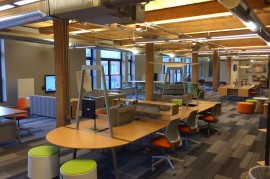By many accounts, the last few years have seen St. Louis rapidly transform into one of the most robust start-up scenes in the country. However, some of the terminology can be confusing for newcomers, especially the locations of where many early-stage companies are located. T-Rex, Cortex, TechArtista: what are people referring to when they throw these terms around? Read this article so your well-informed façade can last a little longer next time you’re talking to an entrepreneur in St. Louis.
T-REx
Where does that name come from? When the Partnership for Downtown St. Louis, the Regional Chamber and the City came together to form the Technology Entrepreneur Center (T.E.C.) they made their first home at the Old Railway Exchange. Hence: TEC + Railway Ex = T-REX.
Where is it? Downtown on the booming Washington Avenue.

T-Rex co-working space
What makes it special? The pricing schedule of Google Ad Words; the share of global capital owned by women; the different legal classifications of employees. Spend enough time in the co-working space at T-Rex, St. Louis’s most prominent startup hub, and you will learn all these things and more. Renowned for its collaborative environment, entrepreneurs in this space can gain skills and knowledge both from their neighbors and from scheduled lunch-n-learns, one example of the frequent programs run by the organizers of the space. Featuring more than 110 startups, 160,000 sq. ft and free pour-over coffee, T-Rex is for entrepreneurs who want to be at the heart of the startup scene. http://downtowntrex.com/
CIC
Where does that name come from? Cambridge Innovation Center (CIC) is a nationally recognized organization of space and service providers for entrepreneurs based in Cambridge, MA. This is where it gets confusing. There are two separate but nearby CIC locations in St. Louis: CIC@4240 (named for its street address) and CIC@CET (named for the Center for Emerging Technology). Both are part of the Cortex Innovation Community, a vibrant 200-acre innovation hub and technology district (usually referred to simply as Cortex).
Where is it? The Central West End and Forest Park P arkway
What makes it special? Home to Venture Café, the exceptionally popular weekly gathering of entrepreneurs and professionals, and CIC is one of the cornerstones of the startup scene in St. Louis. Its proximity to Washington University and Barnes-Jewish Hospital give it unparalleled access to significant research and technology resources. http://stl.cic.us/
Industrious
Where does that name come from? A focus on less quirk and more style led this New-York based co-working space developer to choose a name that clearly shows it means business.
Where is it? Downtown on the booming Washington Avenue.
What makes it special? To differentiate from other co-working places that provide a place to sit and little else, Industrious defines itself as a social office and offers glass-walled private offices as well as communal work space. Amenities include gourmet daily coffee and snacks, beer on tap, and shared season Cardinals box seats. With an emphasis on sophistication, this space is not for workers who want to play ping pong; Industrious is for small businesses, growing startups and satellite corporate offices who mean business. http://www.industriousoffice.com/locations/stlouis
TechArtista
Where does that name come from? TechArtista stems from the Italian soccer term “trequeartista”, which describes a playmaker whose creativity and technique helps score goals.
Where is it? The Central West End. Click on video above for a tour of TechArtista.
What makes it special? For entrepreneurs who live and breathe their business, TechArtista’s 13,500 square foot business and lifestyle ecosystem offers 24/7 access, private parking, two kitchens, laundry, a full gym, changing rooms, showers, private video-chat booths, and a large rooftop wood deck. The space also boasts one of the most tight-knit communities of pooled brainpower. In fact, TechArtista has an in-house designer, videographer and even an attorney that works with all the resident companies. http://www.techartista.org/
Lab1500
Where does that name come from? A project of Ignition Tank, Lab1500 takes its name from the address of its headquarters at 1500 Washington Avenue in downtown St. Louis. The nearly 120 year-old building was rehabbed to capture the industrial yet rustic essence of the abandoned factory. Exposed brick walls, hardwood floors and intricate ceiling tiles make up just a few of the historic elements that were restored and combined with modern-day technology for a creative vibe.
Where is it? Downtown on the booming Washington Avenue.
What makes it special? Lab1500’s vision revolves around its principles of synergy, openness, and creativity. Members have the ability to work in different environments, including the traditional co-working space with communal areas and the relaxed and quiet lounge. The facility and its classroom are also available for members to rent for meetings, classes and events. Keep an eye on this collaborative space as it becomes an integral part of the startup scene in St. Louis. http://www.lab1500.com/#
Nebula
Where does that name come from? Like a nebula is a collection of independent galaxies that come together to form something beautiful, Nebula brings different entrepreneurs together to produce innovation through collaboration.
Where is it? Cherokee Street’s Creative District
What makes it special? Nebula opened in 2010 as the first coworking space in St. Louis, providing workspace for independent contractors, small businesses, non-profits, and creative professionals looking for a place to build, create, develop, and collaborate. http://nebulastl.com/



